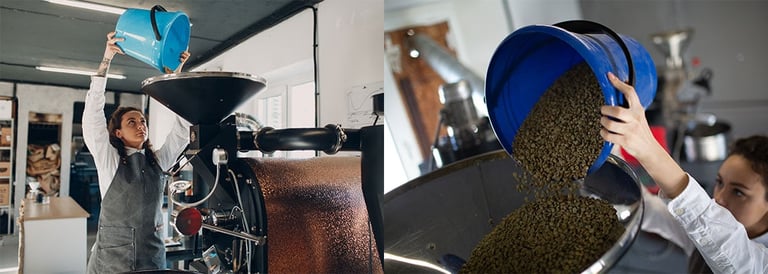- News
- How to eliminate ergonomic hazards in the Food industry
Ergonomic hazards in the Food industry and how to eliminate them

The food production line is a hazardous one. Workers often perform repetitive tasks and manual labour is frequently required to feed machinery or to load and package products.
Manual handling is closely linked to an increased risk of injuries. Therefore, it is extremely important to avoid unnatural postures, elevated levels of repetition, and use of extreme force. Material handling automation can drastically reduce the incidence of such work hazards and enable ergonomically correct working conditions.
Ergonomics is particularly important within the Food industry. Statistics from the US reveal that food processing has the highest lost-workday incidence (LWDI) across all industries with a rate of 6.5 injuries and illnesses per 100 full-time workers, compared to the industry standard of 3.3.
Ergonomic problems in the process line
Prolonged work with repetitive and strenuous tasks can lead to chronic injuries to muscles, tendons and ligaments, nerves, and blood vessels. These injuries are called work-related musculoskeletal disorders (WMSDs). Cumulative trauma disorders (CTDs) and repetitive strain disorders (RSDs) are also common among workers at food processing plants.
The lifting, pulling, and pushing of heavy objects lead to overexerted muscles, and tasks performed in awkward positions result in sprains and strains in various body parts. For instance, lifting a sack to feed a mixer or stretching to reach objects during packaging will inevitably increase the risk of injury. In addition, manual labour often results in fatigue, a common cause of industrial accidents.
However, most injuries result from microtrauma, the build-up of tissue damage from numerous small injuries. Disorders can manifest as tendinitis (inflammation of a tendon), carpal tunnel syndrome (swelling and entrapment of the median nerve in the wrist), thoracic outlet syndrome (squeezing of the nerves and blood vessels between the neck and shoulder) and sciatica (bulging or ruptured discs in the lower back, causing lower back pain that also extends to the legs and feet).
Lots of pain and no gain
Symptoms of these work-related injuries vary from pain from movement, pressure, or exposure to cold or vibrations to decreased range of motion in joints. Sufferers may also experience numbness or discomfort in limbs and fingers, decreased grip strength, and swollen joints. However, it can take weeks, months, or even years for such injuries to develop and there are often no symptoms in the initial stages. Therefore, injuries regularly get diagnosed when irreversible damage has already occurred.
Apart from the physical, psychological, and economical pain suffered by the employee, for the employer these injuries will of course lead to increased costs due to workers being on sick-leave, compensation claims, employee turnover, and so forth. However, although by no means negligible, injury-related expenses are rarely included in overall production cost calculations. Surely, this needs to change.
Automation enhances the process line
To confidently avoid injuries, strenuous and repetitive physical tasks should be automated.
There are plenty of tasks that can be performed with automation, especially when it comes to materials transfer from material pickup to the transfer between different pieces of equipment all the way to packaging.
Vacuum conveying of materials replaces manual feeding with an ergonomic, hygienic, and easy solution. Workers can hold a feeding wand or suction pipe to take the material out of a sack, drum, or barrel and convey it in a closed pipe to the appropriate equipment. This equipment can be a mixer or blender, and the material can be any free-flowing powder, such as flour, sugar, additives, spices, or coffee beans.
These solutions correspond with the level of automation required in the production line. Introducing a pick-up point, like a bag dump station leads to a better, more ergonomic working environment. In this case, the operator has to empty the contents of the bag into the bag dump station and the rest is taken care of by vacuum conveying: there is no need to climb up any stairs or to use forklifts to bring heavy loads up to the top of bigger equipment, such as mixers and blenders.
The materials can also be transferred directly from a bag or barrel with the help of feed pipes or nozzles where the operator can have an upright position during the feeding process.
There are many other steps in food processing which can be executed by Piab vacuum conveyors replacing manual handling of materials and therefore reducing the risk of developing musculoskeletal diseases. Enclosed systems can be created by ensuring the connection between different units in the production line which greatly affects the productivity as well.
Mixing and blending units can be fed, as well as milling and grinding machines. In some cases, finished, sometimes sensitive products, such as candies or chewing gum need to be transferred for packaging. Piab’s devices and accessories enable the transfer of delicate materials, too.
There is other equipment which can also be connected by vacuum conveyors, such as tablet press or stick packing machines and packaging machines.
The entire process can be easily automated in the case of coffee as well, starting with material pickup, milling, grinding, and roasting of beans and ending with the packaging. It even includes steps for scrap handling that reclaim ground coffee and damaged beans throughout the process.
The industrial bakery, Austerschmidt in Germany automated the handling of seeds with Piab conveyors and feeds the hopper for their seed spreading device automatically, instead of an employee having to do this manually with a shovel.
The Polish Polmlek Raciaz uses Paib vacuum conveyors to transfer instant milk granules. They primarily solved product quality issues with automation, but they also benefitted from a reduced physical manpower needed to manage the process.
Another Polish manufacturer, Cronberg manufactures pet food. Their employees skipped carrying bags to 8 meters above the ground floor to feed their mixer by introducing a Piab vacuum conveyor into their process.